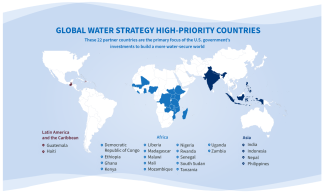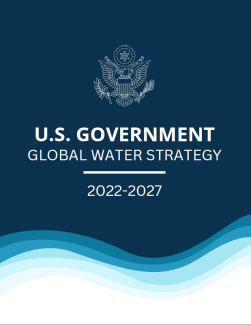The U.S. Global Water Strategy envisions a water-secure world that advances health, prosperity, stability, and resilience through sustainable and equitable water resources management and access to safe drinking water, sanitation services, and hygiene.
Water security, sanitation and hygiene are more important to U.S. foreign policy than ever as the world continues to recover from the most significant public health crisis in 100 years, respond to the increasingly devastating impacts of climate change, and confront growing threats to equality, peace, and security. Yet billions of people worldwide lack access to safe drinking water and sanitation or regularly face water scarcity.
Under the Global Water Strategy, the U.S. government invests in water security to advance health, prosperity, stability, and resilience in the places they are needed the most. The Strategy is required by the Senator Paul Simon Water for the World Act of 2014, co-led by the Department of State and USAID, and reflects contributions from 14 U.S. Government agencies and departments.
The 2022-2027 Global Water Strategy is the primary vehicle to operationalize the White House Global Water Security Action Plan launched by Vice President Kamala Harris on June 1, 2022, while building on and expanding the scope and ambition of the 2017-2022 Strategy. The U.S. government will work through four interconnected and mutually reinforcing strategic objectives:
- Strengthen sector governance, financing, institutions, and markets
- Increase equitable access to safe, sustainable, and climate-resilient water and sanitation services, and the adoption of key hygiene behaviors
- Improve climate-resilient conservation and management of freshwater resources and associated ecosystems
- Anticipate and reduce conflict and fragility related to water
As part of the Global Water Strategy, USAID has also detailed how the Agency will implement the Strategy, providing a results framework, guidance on priorities and technical approaches, and new ambitious targets on water and sanitation access, finance, and strengthening institutions.
The Strategy also describes the targets USAID has set under the 2022-2027 Strategy. During the five-year implementation of the 2017-2022 Global Water Strategy, USAID exceeded its targets to provide 15 million people with access to safe drinking water and eight million people with access to sanitation services. Under the 2022-2027 Strategy, USAID has expanded its ambition and committed to reach an additional 22 million people with access to safe drinking water and 22 million people with access to sanitation over the next five years.
For the first time, USAID’s has elevated its sanitation target to equal to its water target to signal the Agency’s commitment to addressing an often forgotten issue of critical importance to protecting public health, dignity, equity, and our environment. Half of those people reached with services will be those who have never before had basic water or sanitation access. Additional targets focus on accelerating global progress on water and sanitation through capacity strengthening for the many players and institutions that are responsible for delivering high-quality, climate-resilient services that leave no one behind, and mobilizing $1 billion in financing to enable national governments and local partners to lead on solutions that last.
Summary of the Strategy in other Languages
- French: 2022-2027 Stratégie mondiale de l’eau
- Spanish: 2022-2027 Estrategia Global del Agua de Los Estados Unidos
- Portugese: 2022-2027 Estratégia Global da Água dos EUA
- Arabic: إستراتيجية المياه العالمية األمريكية -2027 2022-
Priority Countries and Plans
Aligned with the requirements in the Water for the World Act, USAID has designated 22 high priority countries, effective October 1, 2022. These countries are the primary focus of the U.S. government’s investments to build a more water-secure world amid ongoing challenges of the COVID-19 pandemic, climate crisis, and conflict. Prioritizing work in these countries during the five-year Strategy period on behalf of the American taxpayer will have a measurable impact on the global water and sanitation crisis and is key to meeting the Agency’s five-year goal of directly ensuring 22 million people have access to water services and 22 million people have access to sanitation services, half of whom will be people who have never before had these services.
See where USAID’s Global Water Strategy High-Priority Countries are in the map below and find High Priority Country Plans on Globalwaters.org.

Strategic priority countries are countries where USAID anticipates continued funding for water and sanitation programs due to a combination of strategic considerations and water-related development needs. USAID has classified three strategic-priority countries and regions. Read about the Strategic Priority Countries on the GlobalWaters.org country pages.

